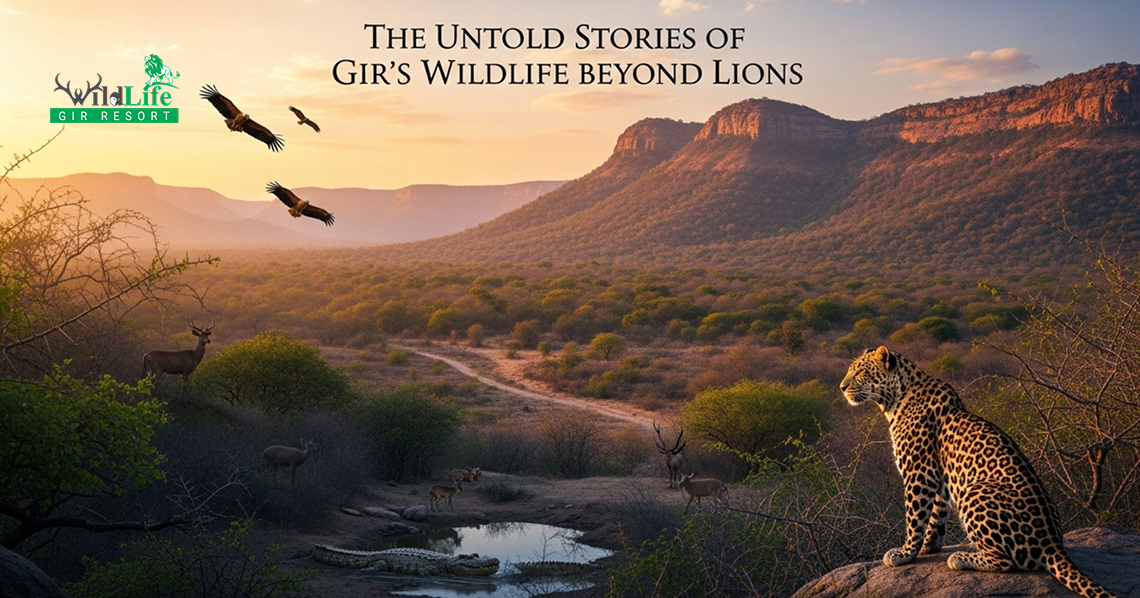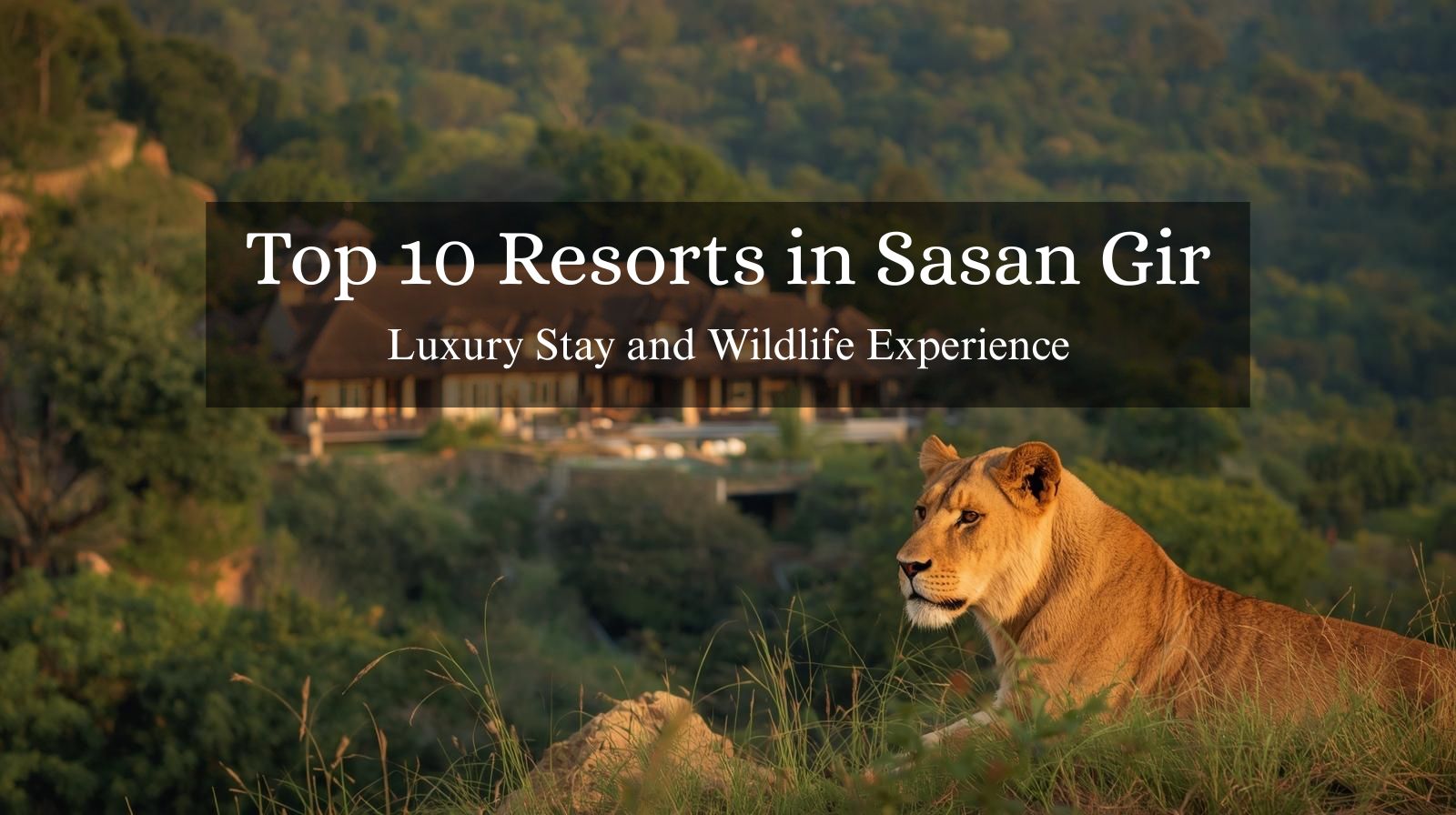The Untold Stories of Gir’s Wildlife Beyond Lions

When people think of Gir National Park, one image usually comes to mind—the majestic Asiatic Lion, roaming freely in its last natural habitat on Earth. This regal predator has become the face of Gir and rightfully so. After all, Gir is the only place in the world where Asiatic lions can still be seen in the wild. But what if I told you that Gir’s story is far more layered, vibrant, and fascinating than lions alone?
Gir is a living, breathing ecosystem—a patchwork of dry deciduous forests, grassy scrublands, rivers, rocky hills, and reservoirs that support a tapestry of life. Every sound, shadow, and rustle hides a tale waiting to be discovered. The lions may be the kings, but the kingdom thrives because of countless other creatures—stealthy leopards, graceful antelopes, colorful birds, nocturnal hunters, and even reptiles that silently shape the balance of this wild paradise.
As someone who has spent years observing and studying Indian forests, I can assure you: the untold stories of Gir’s wildlife beyond lions are equally captivating, sometimes even more surprising. Let’s embark on a deeper journey into this incredible land.
Leopards: The Silent Shadows of Gir
While lions are bold and often spotted in the open, leopards are the mysterious masters of camouflage. Gir has one of the highest leopard densities in India, making it a dream destination for big cat enthusiasts. These elusive predators often thrive in areas closer to human settlements, surviving on livestock or wild prey like langurs and chital.
What’s fascinating is their coexistence with lions. Unlike in Africa, where lions often dominate and kill leopards, in Gir, both species have carved out territories in surprising harmony. Many photographers and naturalists will tell you that spotting a leopard gracefully perched on a tree branch at dusk, with the Gir forest glowing in golden light, is as thrilling as any lion sighting.
The Antelopes: Grace in Motion
Gir is also home to several species of antelope that add elegance to the rugged terrain.
- Chinkara (Indian Gazelle): Known for their shy, delicate beauty, chinkaras are often seen leaping gracefully across open scrublands.
- Nilgai (Blue Bull): India’s largest antelope, the nilgai, is commonly spotted in herds. Their sheer size and bluish-grey coats make them stand out.
- Four-horned Antelope (Chousingha): A rare species found in Gir, with a unique set of four horns—a rare evolutionary trait among antelopes.
The Winged Treasures: Gir for Birdwatchers
Beyond big mammals, Gir is a paradise for bird lovers, with over 300 bird species recorded. From the Kamleshwar Dam to the rocky cliffs, each corner hosts winged wonders.
- Malabar Whistling Thrush: Nicknamed the “whistling schoolboy” for its melodious calls.
- Painted Sandgrouse: Beautifully patterned ground birds blending with Gir’s dry soil.
- Indian Paradise Flycatcher: With its flowing white tail feathers, this bird looks like it belongs in a fairy tale.
- Vultures: Gir remains one of the last strongholds for critically endangered vultures, such as the white-backed vulture, crucial for natural sanitation.
During winter, migratory birds like pelicans and flamingos turn water bodies into spectacular staging grounds. Birdwatching here is not just a hobby; it’s an immersion into an orchestra of calls, colors, and wingbeats.
The Nocturnal World: Creatures of the Night
When the sun sets and safaris end, Gir doesn’t go quiet—it transforms. The forest comes alive with nocturnal beings:
- Striped Hyenas: Often overshadowed by lions, hyenas here are skilled scavengers and hunters, playing a vital ecological role.
- Jungle Cats & Rusty-spotted Cats: Small yet fierce, they stalk rodents and birds under the moonlight.
- Indian Civets & Mongooses: Curious little carnivores that keep the forest floor busy.
- Owls & Nightjars: Their haunting calls remind you that the forest never really sleeps.
For those lucky enough to stay near the forest edges, hearing a hyena’s eerie whoop or an owl’s hoot can be as thrilling as seeing lions roar.
Reptiles: The Overlooked Guardians
Reptiles are the often-forgotten heroes of Gir’s ecosystem. The Marsh Crocodiles of Kamleshwar Dam are legendary—basking lazily in the sun by day, slipping into the waters silently by night. Gir is also home to several snakes, including the Indian cobra, rat snake, and the non-venomous sand boa. These reptiles maintain the balance by keeping rodent populations under control.
Insects & Butterflies: Tiny Marvels with Big Impact
Beyond the visible giants, Gir thrives with smaller, often ignored creatures. Butterflies like the Blue Mormon and Yellow Orange Tip flutter among the wildflowers. Insects play crucial roles in pollination and decomposition. Even fireflies light up the forest edges during the monsoon, adding magic to the Gir experience.
The Human Connection: Maldharis & Coexistence
Wildlife in Gir isn’t limited to animals alone. The Maldhari community—traditional pastoralists—have lived within Gir for centuries. They share space with lions, leopards, and antelopes, grazing their livestock while respecting the rhythm of the forest. Their folktales, songs, and daily life reflect an extraordinary example of coexistence between humans and predators—a rare phenomenon in today’s world.
Beyond Lions: Why It Matters
Why should we care about these untold stories? Because ecosystems are not built on one species alone. The lion may be the star attraction, but the survival of Gir depends on every creature—from vultures that clean up carcasses, to crocodiles that regulate fish, to termites that enrich the soil. Every call, every flutter, every paw print contributes to the survival of the forest.
When visitors broaden their focus beyond lions, they not only enrich their experience but also support a conservation vision that values the whole ecosystem, not just a single species.
Experiencing Gir Differently: Tips for Visitors
- Venture beyond the safari: Spend time near water bodies like Kamleshwar Dam for birdwatching and crocodile sightings.
- Bring binoculars & patience: Spotting smaller animals requires stillness and observation.
- Respect nocturnal life: Even if you can’t enter the forest at night, listen from your resort—it’s magical.
- Talk to locals: The Maldharis and forest guides often share insights that books or websites miss.
Final Thoughts
Gir is not just the kingdom of lions—it’s a living mosaic of life. Its beauty lies in the unseen, the unheard, and the often overlooked. From the rustle of an antelope herd to the haunting call of a hyena, from the flutter of a butterfly to the splash of a crocodile, Gir’s wildlife tells a thousand untold stories.
So the next time you plan your Gir safari, don’t just chase the lion. Pause. Look closer. Listen deeper. Because the real magic of Gir lies in the chorus of life that thrives beyond the king.
Recent posts
December 23, 2025
Best resort gir sasan for a True Wildlife Retreat Full Guide
Best resort gir sasan for a True Wildlife Retreat Full Guide Planning a trip to see Asiatic lions in their...
December 18, 2025
Top 10 Resorts in Sasan Gir for Luxury Stay and Wildlife Experience
Top 10 Resorts in Sasan Gir for Luxury Stay and Wildlife Experience Sasan Gir represents Gujarat’s crown jewel for wildlife...
December 16, 2025
Best Resort in Sasan Gir for a Peaceful Nature Stay and Wildlife Escape
Best Resort in Sasan Gir for a Peaceful Nature Stay and Wildlife Escape Picture this: waking up to the sound...



